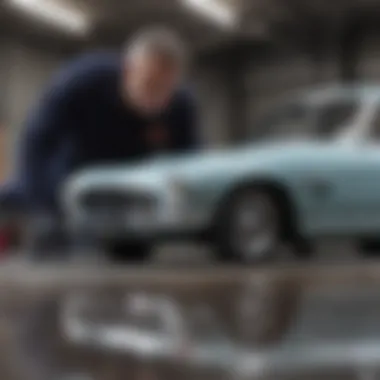Exploring Collectible Cars: Investment and Insights


Intro
The world of collectible cars is filled with enthusiasm, adventure, and deep appreciation for automotive craftsmanship. As a sector that straddles the line between passion and investment, understanding this landscape requires careful examination. Whether one is an avid collector or a curious new buyer, numerous factors inform the value, potential profitability, and ultimate enjoyment of collectible vehicles.
In this journey, we will explore diverse vehicle types and market dynamics at play. The right knowledge not only empowers buyers but also cultivates a sophisticated community of connoisseurs. What are the intricacies that drive the prices of these vehicles? How can one differentiate between an investment and an extravagant expense? Throughout this work, insights will illuminate these questions, guiding potential investors and enthusiasts alike.
An array of topics will be unpacked, from in-depth vehicle reviews to maintenance considerations and market trends. Understanding both the act of collecting cars and the real estate of these vehicles is essential. The value rises not only with age or mileage but also with rarity and historical significance. By studying notable models and market intelligence, readers will be equipped to navigate this intricate sphere.
In the following sections, we will dive into these facets, beginning with vehicle reviews, key specifications, and what makes a collectible car stand out.
Understanding Collectible Cars
Understanding collectible cars goes beyond mere admiration for their antique design or engineering marvels. It encompasses a wide range of factors, from cultural significance to economic potential. In this article, we embark on an insightful journey through the fascinating world of collectible cars. We aim to enlighten car enthusiasts and potential investors by exploring various aspects that define and enhance the value of these vehicles.
Definition and Significance
Collectible cars refer to vehicles that possess a considerable historical, cultural, or monetary value, which often exceeds their original pricing. These can include antique, classic, and modern models.
The significance of collectible cars is multi-faceted. First, they serve as a testament to the advancement of automotive technology over time. Every vehicle tells a story representative of its era. Moreover, they foster a vibrant community among collectors who share knowledge, passion, and resources.
Investing in collectible cars can also yield substantial financial benefits. Market demand fluctuates, but well-chosen vehicles generally appreciate over time, making them a compelling investment compared to traditional assets. An understanding of this market allows collectors to make informed decisions, enhancing both their collection and financial portfolio.
Historical Context
The history of collectible cars is deeply intertwined with the sweeping changes in the automotive industry itself. The earliest automobiles, produced in the late 19th century, mark the inception of collectible automotive culture. Brands like Ford and Cadillac began to set standards that others followed.
Throughout the 20th century, the rise of assembly lines and increased consumer demand led to mass-produced vehicles. Historic models, such as the Model T from Ford and the Corvette from Chevrolet, have carved out their places as icons within car history.
As the decades progressed, social movements, economic factors, and technological advancements influenced automotive designs and demand. For example, the muscle car era in the 1960s and 1970s reflected a desire for performance, while fuel crises spurred interest in smaller, more efficient cars.
By understanding this historical context, collectors can appreciate not just the beauty, but also the significance of the cars in their collections, enriching their passion for the hobby. This comprehension promotes informed acquisitions and strategic selling when the time arises.
In the nuanced world of collectible cars, an understanding of its history can lead to passionate collecting and informed investing.
Types of Collectible Cars
The segment on collectible cars is vital in understanding what defines a vehicle's appeal to collectors and the broader automotive market. Various categories exist, and each holds unique significance and value. Understanding these categories helps enthusiasts identify which types might fit their preferences or investment portfolios. In this section, we will explore three distinct categories: antique cars, classic cars, and modern collectibles.
Antique Cars
Antique cars are generally understood to be vehicles that are at least 45 years old. Owning an antique car often signifies a deep appreciation for automotive history and craftsmanship. These vehicles often represent unique design elements and engineering from a specific era, capturing interest from collectors and enthusiasts.
Importance of Antique Cars:
- Heritage: They serve as mobile pieces of history, embodying the culture and innovations of their time.
- Rarity: Many antique cars were produced in limited numbers, making their remaining examples even more valuable.
- Investment Potential: The value of antique cars often appreciates if maintained well.
Collectors focusing on antique cars need to consider market demand and preservation costs. The right antique car can become not just a passion but a serious financial investment over the years.
Classic Cars
Classic cars are typically defined as models that are at least 20 years old and frequently less than 45 years old. They operate in a unique space where nostalgia meets functionality. Classic cars attract a wide range of enthusiasts, from those who want to enjoy driving them to those who desire them for display or competition.


Characteristics of Classic Cars:
- Diverse Selection: There is a broad array of classic cars, catering to different tastes and budgets. Brands like Ford, Chevrolet, and Jaguar are particularly popular choices.
- Communal Aspect: Various clubs and events focus on classic cars, enhancing their appeal.
- Restore Value: Classic cars often provide significant opportunities for restoration and customization, which can add to their value.
Because of their historical context and appeal, classic cars carry strong residual values, making them wise investments when purchased entries. Positize involves typing right professional restoration work for updating their efficiency without altering their inherent character.
Modern Collectibles
Modern collectibles feature vehicles produced in the last 25 years. This category is where automotive technology meets cultural shifts. Car enthusiasts may gravitate toward modern collectibles because they outline not only technological advancements but also changes in design philosophy.
Notable Aspects of Modern Collectibles:
- Innovation: Many modern collectibles incorporate advanced features for performance, technology, and safety, making them valuable to a younger generation of collectors.
- Limited Editions: Certain models are produced in limited quantities, creating status symbols that are attractive to both collectors and investors.
- Market Trends: Understanding upcoming models that are likely to gain historical importance can yield profitable collecting opportunities.
Investment in modern collectibles can be seen as gambling on future appreciation. Identifying rising stars in the automotive sector can make a collector’s portfolio more exciting.
Understanding these types of collectible cars helps potential collectors and investors navigate the advantages and disadvantages of each category effectively. The choice between them will largely depend on personal affinity, taste, and overall investment strategy.
Investment Potential
Understanding the investment potential in collectible cars is crucial for discerning enthusiasts and potential investors. Collectible vehicles not only represent a segment of automotive history but can also offer promising returns on investment. As interest in the collectible car market has grown, understanding this aspect has become increasingly significant.
Unlike ordinary vehicles, collectible cars have unique attributes that often lead to appreciation in value over time. They provide tangible assets that blend passion with potential financial gain.
Many investors view collectible cars as a diversified portfolio asset. Owning a piece of history, coupled with the latent potential for generational wealth, enhances its allure.
Market Trends
In recent years, the collectible car market has shown noticeable fluctuations. The demand for classic models and limited editions have surged. Some types of cars are currently fetching record prices, suggesting a healthy market. Automotive auctions, online platforms, and classic car shows play crucial roles in shaping these market trends.
Social platforms and websites such as Reddit and Facebook have become essential for enthusiasts to share information and trends. Keeping abreast of these changes becomes vital for anyone considering an investment.
Factors Influencing Value
Gaining an understanding of the factors influencing value is key in collectible car investments. This includes rarity, provenance, and condition.
Rarity
Rarity is a fundamental aspect that significantly affects a vehicle's desirability. Cars produced in limited quantities are generally more sought after, enhancing their value. Collectors often look for models with low production numbers or unique features to bolster their collections. Rarity not only amplifies the car's appeal but can provide substantial appreciation over time. However, it can also make sourcing parts for restoration challenging.
Provenance
Provenance refers to the history of ownership and documentation of a vehicle. A car with a well-documented history often fetches higher amounts compared to those lacking detailed records. Provenance gives potential buyers confidence in the car’s history and authenticity. Vehicles that have been owned by renowned figures or featured in significant events tend to hold added value. On the downside, tracing provenance can be time-intensive nested and requires a meticulous approach to ensure robust verification.
Condition
Condition encompasses how well a car has been maintained over its lifetime. A well-preserved or restored vehicle is always more appealing to collectors. Generally, the vehicles rated highly on condition metrics receive top dollar in auctions and sales. Such standards include originality, mechanical integrity, and aesthetic quality. However, maintaining a vintage car in pristine condition can be costly and may require specialized skills.
Investment Strategies
Understanding effective investment strategies is paramount for those looking to enter the collectible car market. Research is essential – one must know the models and market trends. Networking with other collectors can provide valuable insight into potential purchases. Following automotive journalism and auction results can also offer guidance.


Key strategies include differentiating between vehicles recognized for their historical significance and those suitable for short-term flipping. Buyers should understand their own profit motivations and possess clear outcomes for each investment. Additionally, thoroughly inspecting each vehicle before purchase remains crucial. This evaluation should include documentation of condition and comprehensive provenance reviews.
Maintaining a balanced perspective on passion versus profit will yield the most enjoyable and successful experience in the realm of collectible cars. Maintaining informed and engaged within this community provides not just love for the craft but significant release rates for investment potential.
Collectible Cars as a Passion
The allure of collectible cars extends beyond simple ownership; it embodies a passionate commitment to automotive history, design, and engineering. Collectors are not just investors; they are fervent enthusiasts who appreciate the story each car tells. This passion can transform straightforward collecting into an immersive experience, predicated on personal connection and deep appreciation for a vehicle's character.
Many collectors find themselves developing lifelong friendships that stem from a common interest. Joining clubs and communities strengthens ties among enthusiasts. This social network builds support and fosters knowledge-sharing about collecting best practices. Such connections can enhance knowledge not just about chosen vehicles, but across the entire automotive culture.
Restoration Processes
Restoration can be a rewarding part of collectible car ownership. Understanding restoration processes necessitates several considerations. These involve not only technical skills but also vision for preserving the vehicle’s integrity. Knowledge of components, materials, and techniques becomes essential. Proper restoration maintains a car's original charm while ensuring function and aesthetics.
Here’s a brief look at the typical restoration stages:
- Assessment: Conduct a thorough inspection to determine the car’s condition. Identify areas of deterioration as well as components requiring preservation.
- Planning: Set priorities based on assessment. Plan out specific tasks and budget for parts and labor.
- Disassembly: Carefully disassemble the vehicle with as little damage as possible to original pieces. Sort and label parts to ensure smoother reassembly.
- Repair: Focus on repairing what can be salvaged. Metal work, paint restoration, and upholstery are key aspects.
- Reassembly: Bring everything back together, paying close attention to the details. Adjust to ensure proper fit and finishes.
The challenges involved can be daunting, but flawless execution often results in a vehicle reflecting crafting excellence. Type and era of vehicle dictate restoration methods. Some owners may prefer near-original integrity, while others may opt for modified appearances or enhancements which impact value accordingly.
Communities and Clubs
Being part of a community amplifies the experience of collectible cars. Enthusiast clubs offer a platform for sharing ideas and viewpoints. These groups engage in various activities such as car shows, rallies, and restoration workshops.
Participating in such communities grants members:
- Access to valuable resources, from parts suppliers to knowledgeable mechanics, making maintenance and restoration easier.
- A chance to display your car and admire others in showcases, increasing appreciation for design and craftsmanship.
- Networking opportunities that could lead to potential sales or trades, satisfying both practical needs and aspirations.
- Insight into automotive history through discussions and events centered around makes and trends in the industry that resonate.
Many greatly enjoy connecting with fellow enthusiasts online as well. Various platforms like Reddit and Facebook can host active communities focused on different collectible car types.
Challenges in Collecting
Collecting cars involves more than just passion. There are various hurdles that collectors often face. In this section, we will address the key challenges related to maintenance, market fluctuations, and legal issues. Understanding these factors is crucial for both new and veteran collectors to navigate this engaging but complex hobby effectively.
Maintenance Requirements
Maintenance is a critical aspect of owning collectible cars. Unlike standard vehicles, collectible cars may require specialized care. The age of these cars often means aging parts which can be harder to replace. Regular maintenance ensures that these vehicles can be driven, exhibited, or restored when needed.
To maintain a collectible car, owners should focus on:
- Regular Inspections: Frequent checks for parts such as brakes, tires, and fluids help to avoid future issues.
- Quality Parts: Sourcing authentic or high-quality components for replacement is essential. Utilizing low-quality parts can compromise performance and value.
- Experienced Mechanics: Finding a mechanic knowledgeable in collectible cars is useful. Such professionals know nuances that regular car mechanics might overlook, helping preserve the vehicle's life.
Maintaining a collectible car might prove to be time-consuming and costly. However, following a proper maintenance regime can assure that the car retains its historical significance and monetary value.
Market Volatility
Market volatility can affect collectible car investments significantly. Unlike real estate or stocks, which have established norms and fluxes, the collectible car market can be unpredictable. Fluctuations often revolve around buyer interests, economic cycles, and rarity of models.
Key factors influencing market volatility include:
- Economic Conditions: General economic downturns can limit discretionary spending, affecting car prices.
- Cultural Trends: As interests shift, the focus on specific makes or models may decrease or rise.
- Auction Results: High-profile auctions often set precedents, swaying public interest and overall market dynamics.


Collectors must actively watch the market and grasp trends. Understanding how these market factors function can better equip collectors, whether they plan to buy, hold, or eventually sell in the future.
Legal Concerns
Legal matters can add considerable complexity to collecting. Challenges in legal ownership, registration protocols, and licensing must be recognized by every serious collector.
Important legal considerations include:
- Documentation: Proper paperwork, including titles and histories, is essential. Missing documentation can dramatically reduce a vehicle's value.
- Registration: Different states or regions may have various registration requisites for vintage cars. Failing to comply can result in hefty fines or invalidation of ownership.
- Restoration Regulations: Some regions impose rules affecting how vehicles can be restored or modified, particularly if significant changes are made. Owners must ensure that they remain within legal limits.
Collecting cars can offer a fulfilling experience, but the associated challenges need to be managed skillfully to ensure lasting enjoyment and investment value.
Engaging in the world of collectible cars adds much excitement, but those trails have many challenges that require thoughtful navigation. Acknowledging and understanding these professional aspects protects one's investment and enhances aesthetic and emotional benefits.
Future of Collectible Cars
The future of collectible cars reflects significant transformations defined by evolving market dynamics and technological advancements. This section aims to shed light on how these elements shape the collecting landscape, benefiting enthusiasts and investors alike. Staying informed about upcoming trends and emerging technologies is critical for making sound decisions. It sets a context where passion meets prudent investing.
Emerging Trends
Emerging trends in the collectible car market provide insights into consumer interests and investment possibilities. Recent years show a palpable shift towards sustainable and electric vehicles within the collector community. Classic and growing brands like Tesla attract curiosity from traditional collectors and modern enthusiasts for their groundbreaking technology. With nimble moves adaption in taste, it is wise to note rarity based not only on production figures but also on the growing importance of innovative features.
Furthermore, certain niche segments are evolving. For example, vehicles with historical significance or unique design features appeal more each day. Brands like Ferrari and Porsche lean into modern excitement, joining rallies, and featuring sports enthusiasts prominently within their events. Such market excitement enhances these segments' desirability, making it crucial for collectors to stay abreast of shifts and opportunities.
Key Trends to Watch:
- Increasing demand for limited-edition vehicles that emphasize rarity.
- Shift towards electric vehicle enthusiasts participating in the scene.
- Rise in online platforms for auctions, making collecting more accessible.
- Heightened focus on historical documentation and provenance to verify value.
The Role of Technology
Technology plays an invaluable role in shaping the future of collectible cars. Innovations in the automotive realm influence all aspects from preservation to communication. Vehicle history reports powered by blockchain technology create a transparent record, adding value to cars as they change hands. Consequently, this transparency fosters trust among buyers and sellers.
Moreover, the online marketplace has revolutionized how enthusiasts purchase and sell vehicles. Platforms like Bring a Trailer open avenues for mainstream viewers to engage, thereby driving liquidity in collectibles. When it comes to restoration, advanced technologies in paint and material science enhance the likelihood of maintaining or even boosting a collectible's value over time.
Decoding the role of technology includes recognizing significant aspects such as:
- Enhanced digital marketing strategies influence vehicle desirability.
- Utilization of social media communities on platforms like Reddit enables lifestyle discovery.
- Development of applications dedicated to tracking car values
- The embracing of 3D printing allows collectors to replicate hard-to-find parts.
The landscape of collectible cars constantly evolves, influenced by technology and today’s buyers’ interests. Understanding these changes sets collectors on a proactive path.
In summary, looking toward the future in collectible cars involves embracing both emerging trends and the transformative nature of technology. Collectors equipped with this knowledge can navigate the intricate landscape driven by innovation while indulging their passion for automotive excellence.
End
Understanding the significance of collectible cars is crucial for enthusiasts and potential investors alike. This article has explored various aspects of collectible vehicles, from their historical importance to their investment potential. Each segment illustrates crucial elements that anyone involved in this hobby should consider.
Final Thoughts on Collectible Cars
Collectible cars do not merely represent a mode of transportation; they embody history, style, and, for many, a deep-seated passion. Investing in these vehicles tends to combine personal enjoyment with financial strategy.
- Historical Significance: Classic and antique cars provide a glimpse into the evolution of automotive engineering. They capture different eras and tell stories that enhance their desirability.
- Investment Value: As discussed earlier in the article, factors such as rarity, provenance, and condition play a major role in determining a vehicle's market price. Wise investments may yield appreciable returns over time.
- Community Engagement: Being part of collectors' communities can offer networking opportunities, knowledge shared amongst like-minded individuals, and support—all beneficial for smoother ownership experiences.
However, potential collectors and investors must remain aware of challenges in maintenance, market fluctuations, and legal considerations. Foundational knowledge helps in navigating these potential pitfalls.
To fully embrace collecting cars, one must delve into repair techniques, the significance of authenticating documents, and the market's pulse. Lastly, it is wise to strike a balance between passion and investment strategies, as doing so ensures sustained enjoyment throughout the collecting journey.
"Collectible cars are not just automobiles; each model stands as a testament to human ingenuity, tradition, and the lively history of the motoring world."















